Abstract
We argue that some parenthetical-like clauses in ASL can take both intermediate and maximally wide scope outside of if-clauses and attitude verbs. Specifically, we investigate embedded coordinations, of the form … SAY [IF Clause-1 Clause-2 PLUS Clause-3, …], and argue that Clause-2 may in some cases be interpreted with wide and intermediate scope (above SAY, or between SAY and IF). The key to our paradigm is that we mark the scope of IF and SAY with non-manual markers (Brow Raise and/or Role Shift). By exempting Clause-2 from these non-manuals, we force it to outscope the relevant operator, including when it might be expected to create a syntactic island. Wide scope replicates the behavior of parentheticals and appositives in other languages. Intermediate scope is particularly interesting because it mirrors with full clauses the behavior predicted by some theories for some English appositives (Schlenker 2010, to appear a). The ASL data might thus lend support to the existence of a mechanism of high attachment in situ (McCawley 1981, 1998). Alternatives in terms of island-escaping covert movement or in situ indexing face significant challenges.
Similar content being viewed by others
Notes
Schlenker (2010, 2013/2020) proposes a theory in which matrix attachment is just one possibility: attachment to intermediate propositional nodes is possible as well. It seems to us that McCawley (1998) took matrix attachment to be the only possibility, as suggested by his remark that “a nonrestrictive clause accomplishes a separate speech act from the sentence in which it appears” (p. 448), and that “this sketch is neutral with regard to whether the two Ss [i.e. the main clause and the appositive -PS] even make up a constituent.”
We do not exclude the possibility that it might be permissible to copy the appositive in the elided clause; our point is that this is not obligatory. As an editor notes, (i) probably suggests that Emma read a book by Jane Austen. The reason is not hard to find: the second clause would make a rather trivial point without the appositive. We do not seek to explain what determines the choice between copying the appositive or not in such cases (nor how copying works if it does).
(i) Anna read a book, which had been written by Jane Austen, and Emma did too.
In (3)a,b, a conditional mood can be used instead of the past tense, as is illustrated in (i). This is expected on a matrix attachment reading: the parenthetical and appositive are in this case interpreted outside the scope of the if-clause, and give rise to a reading of ‘modal subordination’ on which if tomorrow I called the chair, the latter would call the dean. This inference is absent from (3)a,b,
-
(i)
-
a.
If tomorrow I called the chair, who would in turn call the dean, then we would be in deep trouble.
-
⇒
if I tomorrow called the chair, he would call the dean
-
b.
If tomorrow I called the chair (he would in turn call the dean) then we would be in deep trouble.
-
⇒
if I tomorrow called the chair, he would call the dean
-
a.
-
(i)
See Schlenker 2013/2020 for a more complete paradigm, and quantitative acceptability and inferential judgments obtained from 8 consultants. A related paradigm is discussed in greater detail below (= (9)).
This discussion of elicitation methods and transcription conventions is similar to one that appears in Schlenker (2018).
We usually provide complete quantitative judgments when there is more than a 2-point difference in the judgments obtained for a given sentence, but this case just didn’t arise in the present piece, indicating that acceptability and inferential judgments were rather stable for our consultant.
This paragraph recapitulates transcription conventions that are found elsewhere, and it is thus similar to homologous paragraphs in the literature.
Role Shift and Brow Raise are typically easier to perceive, but Brow Lowering may be much more subtle, and our transcriptions are correspondingly less secure in the latter case.
The behavior of restrictive relative clauses is entirely expected. Take (7)a. Students that were incompetent is a stronger (i.e. more restrictive) property than students. Less than five is downward-monotonic relative to its nominal argument, which means that a logically stronger property gives rise to a logically weaker meaning.
Schlenker (2013/2020) explains the stronger endorsement of the inference in (9)a than in (9)c by a (weak) projection phenomenon reminiscent of presupposition projection.
Two remarks should be added:
(i) The type system posited by Potts (2005) is designed to ensure that meanings in the CI dimension do not affect the at-issue meaning obtained for a given sentence. Basic types (e, s, t) exist both in a standard (at-issue) version and in a CI version. But no complex type allows an expression to take as argument a CI-type and return an at-issue type; as a result, CI types do not affect the computation of at-issue meanings. See Potts (2005) for discussion, and Schlenker (to appear a) for a summary.
(ii) Technically, Potts (2005) posits a rule of “parsetree interpretation” that collects all the propositional types that correspond to supplements, irrespective of where in the tree they are found.
Schlenker (2013/2020) discusses several possible cases of intermediate scope in English and French, including (i), with average judgments on a 7-point scale (from a survey with 8 native speakers of American English; the structures in a. and b. should be understood to fill ___):
-
(i)
Context: there is discontent with the current chair, John, but many people didn’t say anything to the dean for fear that she would take excessive action. I justify this course of action:
If each of the faculty had mentioned the fact that they didn’t like John ____ we would now feel terrible.
-
a.
5.4, who had gotten fired as a result,
-
b.
2 (he had gotten fired as a result)
-
a.
The example in (i)a involves a modally interpreted pluperfect licensed within the scope of the if-clause, while (i)b serves as a control: the clausal parenthetical should only be able to attach at the matrix level, and for this reason the counterfactually interpreted pluperfect should not be licensed and the sentence should be deviant (as is the case).
The modally interpreted pluperfect (and the intuitive truth conditions) show that the appositive relative clause in (i)a is interpreted within the scope of the if-clause. But it also seems to be interpreted above the scope of each of the faculty: on the most plausible reading, the condition is that [each of the faculty mentions the fact that he doesn’t like the chair] and the latter gets fired as a result of this unanimous opinion; attachment under each of the faculty yields an implausible reading “on which for each faculty f, the chair could be fired on the strength of f’s particular opinion” (Schlenker 2013/2020).
-
(i)
As Sandler and Lillo-Martin (2006) note (p. 469), “if the parenthetical indicates the speaker’s viewpoint, there will be a body shift as well as a change in facial expression to the signer’s opinion, with a return to the original position and WH-question expression following the parenthetical,” as shown in their example in (i) (we preserve their transcription, where ∧ in TRUE∧BUSINESS presumably indicates that the ASL word is made of two component parts).
-
(i)

-
(i)
Depending on the case, Brow Raise in Clause-3 starts on or after &; we do not know of any consequences of this variation.
Liddell (1986) argues that the consequent of ASL conditionals is marked by another non-manual, head thrust. Since we do not aim to provide an exhaustive transcription of non-manuals, and this one does not interact with our goals (as the action will be in the antecedent clause), we disregard this point in what follows.
We follow in part the discussion of Schlenker (to appear a).
IX-arc appears to be signed in a neutral position, so no locus is assigned to it.
The stronger endorsement of the inferences in (19)c seems to be due to the wide scope interpretation of Clause-2 combined with plausibility reasoning. As the consultant wrote in the first of the two additional judgments bearing on these questions, “it is likely that the students would know how the others feel, but not necessarily” ([JL 18.10.19]).
Wilbur (2017) writes that “a sentence with an overt ‘that’ complementizer is usually branded as ‘Englishy’ by native signers, reflecting the influence of the dominant spoken language; the literature suggests similar situations across better-studied SLs.” There is no trace of this effect in our consultant’s judgments: not only are the sentences rated very highly, but the consultant did not make use of the option (which is systematically available in our elicitation forms) of writing ‘E’ for ‘English influence.’ An anonymous reviewer informs us that, for her consultant, the sentences become ungrammatical in the absence of Role Shift or THAT. We are neutral on this issue, which is immaterial for our purposes: all we need is a construction in which the clauses in (26)a-c are clearly embedded and involve indirect discourse. This is the case here (among others because Ann is referred to with IX-b rather than with a first person pronoun), and this is enough for our purposes.
The inferential question was: Do you derive the inference that the economics professor studied at a university that’s popular (i) in linguistics? (ii) in economics? (Indicate with which strength you derive the relevant inference: 1 = no inference; 7 = strongest inference.)
For X \({SAY^{w*}}_{{w}}\) F, the intended truth conditions are: all worlds w compatible with what X believes in w* satisfy F. Similarly, for \({\mathit{IF}^{w}}_{{w'}}\ F, G\), the intended truth conditions are: every accessible world w’ from w which satisfies F satisfies G, or alternatively: the closest worlds w’ from w which satisfy F also satisfy G (see for instance Stalnaker 1968 and Schlenker 2004 for the latter, non-monotonic semantics).
As seen in our paraphrase of the truth conditions, this result does not hinge on a ‘material implication’ analysis of the IF-clause: we assume instead that its meaning is that of a strict conditional, which quantifies over all accessible worlds w′ from a world of evaluation w. The source of the problem is that when Clause-2 is false in w, no world w′ at all can make true the conjunction Clause-1w′ Clause-2w & Clause-3w′.
One important requirement is that the consequent Clause-4 must be predicted to hold in all the accessible worlds from w that satisfy Clause-1 and Clause-3.
In addition, we do not know of evidence that Brow Raise marks possibility. For instance, its uses to mark focus (e.g. Schlenker et al. 2016) do not fall under that description.
An anonymous reviewer suggests that the degraded nature of the extraction out of coordinate structures might be due to processing rather than to syntax. If so, the question becomes: if our ASL clauses are also extracted out of coordinate structures, shouldn’t the same processing difficulty extend to them as well? This seems hard to decide in the absence of a more precise theory of the processing difficulty evoked here.
This need not be unproblematic because p is type t whereas the conditional might require that it should be of type <s, t>.
Standardly, presupposition under attitude verbs such as say and believe works by requiring that every world compatible with what the agent says/believes satisfies the presuppositions of the embedded clause (Heim 1992). On the presuppositional analysis on which the conditional yields a failure if its antecedent contains a contradiction, the requirement for (58)c will imply that every world compatible with what Ann says makes Clause-2 true.
References
Beaver, David. 2001. Presupposition and assertion in dynamic semantics. Stanford: CSLI.
Brasoveanu, Adrian. 2010. Decomposing modal quantification. Journal of Semantics 27: 437–527.
Chemla, Emmanuel. 2009. Presuppositions of quantified sentences: experimental data. Natural Language Semantics 17(4): 299–340.
Davidson, Kathryn. 2015. Quotation, demonstration, and iconicity. Linguistics & Philosophy 38(6): 477–520.
Del Gobbo, Francesca. 2003. Appositives at the interface. PhD diss., University of California, Irvine.
Fabricius-Hansen, Cathrine, and Kjell Johan Sæbø. 2004. In a mediative mood: The semantics of the German reportative subjunctive. Natural Language Semantics 12: 213–257.
Harris, Jesse A., and Christopher Potts. 2009a. Perspective-shifting with appositives and expressives. Linguistics & Philosophy 32(6): 523–552.
Harris, Jesse A., and Christopher Potts. 2009b. Predicting perspectival orientation for appositives. Chicago Linguistic Society (CLS) 45(1): 207–221.
Heim, Irene. 1991. Artikel und Definitheit. In Handbuch der Semantik, eds. Arnim von Stechow and Dieter Wunderlich. Berlin: de Gruyter.
Heim, Irene. 1992. Presupposition projection and the semantics of attitude verbs. Journal of Semantics 9(3): 183–221. https://doi.org/10.1093/jos/9.3.183.
Heim, Irene, and Kratzer. 1998. Semantics in generative grammar. Oxford: Blackwell.
Koulidobrova, Elena. 2017. Elide me bare: Null arguments in American Sign Language. Natural Language and Linguistic Theory 35(2): 397–446. https://doi.org/10.1007/s11049-016-9349-5.
Koulidobrova, Elena, and Kathryn Davidson. 2015. Watch the attitude: Role shift and embedding in ASL. In Sinn und Bedeutung 19, eds. Eva Csipak and Hedde Zeijlstra. 338–356.
Koulidobrova, Elena, and Kathryn Davidson. to appear. Attitude embedding predicates and indexicals under role shift in ASL. In Papers for Angelika (Festschrift for Angelika Kratzer).
Liddell, Scott K. 1986. Head thrust in ASL conditional marking. Sign Language Studies 52: 243–262.
Liddell, Scott K. 2003. Grammar, gesture, and meaning in American Sign Language. Cambridge: Cambridge University Press.
Lillo-Martin, Diane. 1991. Universal grammar and American Sign Language: Setting the null argument parameters. Dordrecht: Kluwer Academic Publishers.
McCawley, James D. 1981. The syntax and semantics of English relative clauses. Lingua 53: 99–149.
McCawley, James D. 1998. The Syntactic phenomena of English, 2nd edn. Chicago: Chicago University Press.
Neidle, Carol, and Dawn MacLaughlin. 2002. The distribution of functional projections in ASL: Evidence from overt expressions of syntactic features. In Functional structure in the DP and IP: The cartography of syntactic structures, ed. G. Cinque. Vol. 1, 195–224. London: Oxford University Press.
Percus, Orin. 2000. Constraints on some other variables in syntax. Natural Language Semantics 8(3): 173–229.
Poschmann, Claudia. 2018. Embedding non-restrictive relative clauses. Sinn und Bedeutung 22.
Potts, Christopher. 2005. The logic of conventional implicatures. Oxford studies in theoretical Linguistics. Oxford: Oxford University Press.
Potts, Christopher, Ash Asudeh, Seth Cable, et al.. 2009. Expressives and identity conditions. Linguistic Inquiry 40(2): 356–366.
Quer, Josep. 2005. Context shift and indexical variables in sign languages. In Semantic and Linguistic Theory (SALT 15). Ithaca: CLC Publications.
Quer, Josep. 2013. Attitude ascriptions in sign languages and role shift. In 13th Meeting of the Texas Linguistics Society, ed. Leah C. Geer, 12–28. Austin: Texas Linguistics Forum.
Quer, Josep. 2016. Intonation and grammar in the visual-gestural modality: A case study on conditionals in Catalan Sign Language (LSC). In Intonational grammar in Ibero-Romance: Approaches across linguistic subfields, eds. Meghan E. Armstrong, Nicholas Henriksen, and Maria del Mar Vanrell, 369–386. Amsterdam: Benjamins.
Sandler, Wendy. 2010. Prosody and syntax in sign languages. Transactions of the Philological Society 108: 298–328.
Sandler, Wendy, and Diane Lillo-Martin. 2006. Sign Language and Linguistic Universals. Cambridge: Cambridge University Press.
Schlenker, Philippe. 2004. Conditionals as definite descriptions (a referential analysis). Research on Language and Computation 2: 417–462.
Schlenker, Philippe. 2010. Supplements within a unidimensional semantics I: Scope. In Logic, language and meaning: 17th Amsterdam colloquium, eds. Maria Aloni, Harald Bastiaanse, Tikitu de Jager, and Katrin Schulz, 74–83. Amsterdam: Springer.
Schlenker, Philippe. 2014. Iconic features. Natural Language Semantics 22(4): 299–356.
Schlenker, Philippe. 2017a. Super monsters I: Attitude and action role shift in Sign Language. Semantics & Pragmatics 10. 2017.
Schlenker, Philippe. 2017b. Super monsters II: Role shift, iconicity and quotation in Sign Language. Semantics & Pragmatics 10. 2017.
Schlenker, Philippe. 2018. Visible meaning: Sign Language and the foundations of semantics. Theoretical Linguistics 44(3–4): 123–208.
Schlenker, Philippe. 2013/2020. Supplements without bidimensionalism. Ms., Institut Jean-Nicod and New York University.
Schlenker, Philippe. to appear a. The semantics and pragmatics of appositives. In Wiley Blackwell Companion to semantics, eds. Daniel Gutzmann, Lisa Matthewson, Cécile Meier, Hotze Rullmann, and Thomas Ede Zimmermann. Hoboken: Wiley.
Schlenker, Philippe. to appear b. Iconic presuppositions. Natural Language & Linguistic Theory.
Schlenker, Philippe, Jonathan Lamberton, and Mirko Santoro. 2013. Iconic Variables. Linguistics & Philosophy 36(2): 91–149.
Schlenker, Philippe, Valentina Aristodemo, Ludovic Ducasse, Jonathan Lamberton, and Mirko Santoro. 2016. The unity of focus: Evidence from Sign Language. Linguistic Inquiry 47(2): 363–381.
Selkirk, Elisabeth. 2005. Comments on intonational phrasing in English. In Prosodies, eds. Sonia Frota, Marina Vigario, and Maria Joao Freitas, 11–58. Berlin: de Gruyter.
Stalnaker, Robert. 1968. A theory of conditionals. Studies in logical theory, Vol. 2. Monograph: American Philosophical Quarterly.
Stowell, Tim. 2005. Appositive and parenthetical relative clauses. In Organizing grammar: Linguistic studies in honor of Henk van Riemsdijk, eds. Hans Broekhuis, Norbert Corver, Jan Koster, Riny Huybregts, and Ursula Kleinhenz, 608–617. Berlin: de Gruyter.
Wilbur, Ronnie. 2000. Phonological and prosodic layering of non-manuals in American Sign Language. In The signs of language revisited: an anthology to honor Ursula Bellugi and Edward Klima, eds. Karen Emmorey and Harlan Lane, 215–244. Hillsdale: Erlbaum.
Wilbur, Ronnie B. 2011. Nonmanuals, semantic operators, domain marking and the solution to two outstanding puzzles in ASL. Sign Language & Linguistics 14: 148–178.
Wilbur, Ronnie B. 2017. Internally-headed relative clauses in sign languages. Glossa 2(1): 25. https://doi.org/10.5334/gjgl.183.
Wilbur, Ronnie B., and Cynthia Patschke. 1998. Body leans and marking contrast in ASL. Journal of Pragmatics 30: 275–303.
Acknowledgements
Many thanks to Amir Anvari for checking all averages, and to Lucie Ravaux for helping with the bibliography, and for double-checking the computation of all averages cited in the text, including by putting together the Excel file made available in the Supplementary Materials. Jeremy Kuhn provided helpful terminological advice in the last stage. I am also very grateful to two anonymous reviewers for Natural Language & Linguistic Theory and to editor Ashwini Deo for constructive comments.
ASL consultant for this article: Jonathan Lamberton. Special thanks to Jonathan Lamberton, who provided exceptionally fine-grained data throughout this research; his contribution as a consultant was considerable. We are also grateful to him for correcting ASL transcriptions and translations, and for allowing us to make two lightly anonymized videos publicly available.
Author information
Authors and Affiliations
Additional information
Publisher’s Note
Springer Nature remains neutral with regard to jurisdictional claims in published maps and institutional affiliations.
Grant acknowledgments: The research leading to these results received funding from the European Research Council under the European Union’s Seventh Framework Programme (FP/2007-2013) / ERC grant agreement N°324115–FRONTSEM (PI: Schlenker), and also under the European Union’s Horizon 2020 Research and Innovation Programme (ERC grant agreement No 788077, Orisem, PI: Schlenker). Research was conducted at Institut d’Etudes Cognitives, Ecole Normale Supérieure – PSL Research University. Institut d’Etudes Cognitives is supported by grant FrontCog ANR-17-EURE-0017.
Electronic Supplementary Material
Below are the links to the electronic supplementary material.
Appendix: Problems with a movement-based account
Appendix: Problems with a movement-based account
We explore in greater detail the possibility that wide and intermediate scope readings of the ASL clauses studied in this piece arise through covert movement. This analysis faces two challenges: it might require movement out of some syntactic islands; and it might not yield the right meanings.
- □:
-
Syntactic islands
A movement account of wide and intermediate scope readings is initially implausible because the movement would need to cross a classic island, namely an IF-clause. But as we now show, the situation is more complicated than it seems, because our consultant tends to accept wh-extraction out of the relevant IF-clauses. On the other hand, extraction out of coordinate structures is sharply degraded. Thus if we take the extraction in (13)b and possibly (13)c (repeated as (41)b,c) to be out of a coordinate structure island in addition to an IF-clause, a movement analysis will prove implausible.
-
(41)

In (42)b and (43)b, wh-extraction out of an IF-clause is only minimally degraded relative to the controls, including ones with a resumptive pronoun, as in (42d)–(43d). The constructions we picked are not agreement verbs (also called ‘indicating verbs’ or ‘directional verbs’), which are independently known to obviate some binding-theoretic effects (Lillo-Martin 1991). But it is worth noting that Koulidobrova (2017) has further examples of apparently licit extraction out of an island in the absence of agreement or resumption.
-
(42)
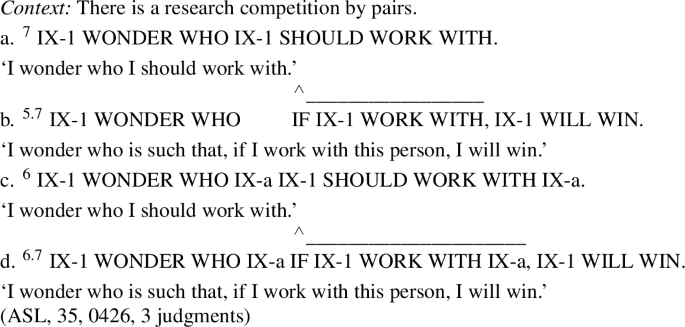
-
(43)
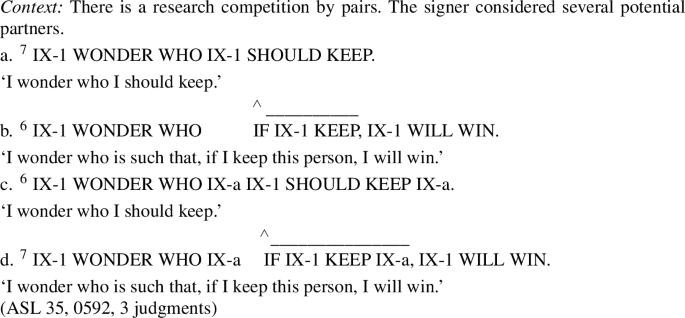
By contrast, extraction out of a coordinate structure with an overt AND is degraded for our consultant, as seen in (44)a,b and (45a,b. These contrast with the acceptable versions involving resumptive pronouns in (44)c,d–(45)c,d.Footnote 27
-
(44)
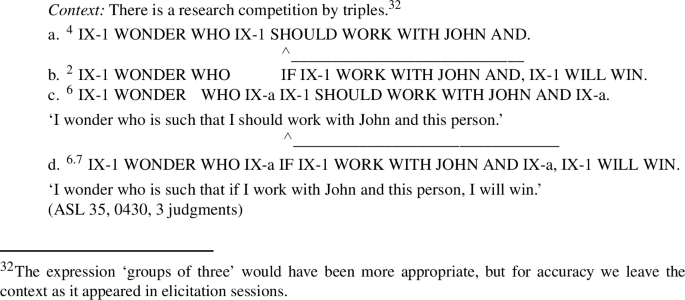
-
(45)

The same results are obtained with asyndetic coordinate structures as in (46)b,c and (47)b,c (we do not know why (46)b is slightly more acceptable than (47)b).
-
(46)
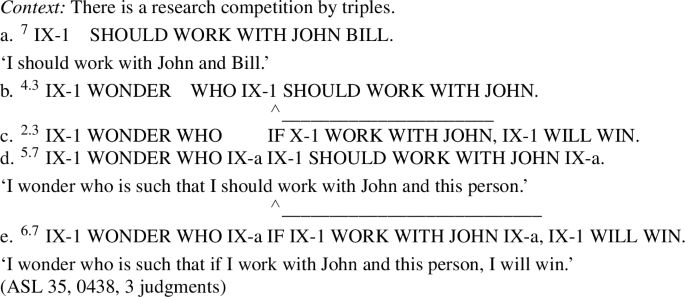
-
(47)
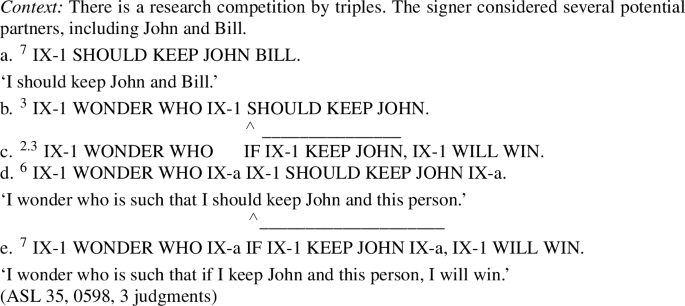
In sum, no clear island effects are obtained with wh-extraction out of IF-clauses alone, but clear violations are obtained for wh-extraction out of coordinate structures, with or without an overt AND. Thus if we take the extraction in (41)b,c to be out of a coordinate structure island, we would expect it to be degraded, contrary to the judgments our consultant obtained. This is unexpected for an analysis based on covert movement, unless covert movement can somehow escape the coordinate structure island constraint.
- □:
-
Meaning
A movement analysis faces another challenge: it is not clear that it yields the right meaning. Consider for instance the wide scope reading obtained in (26)c, repeated as (48):
-
(48)

This sentence is schematically represented in (49)a. Let us take Clause-2 to be (as is natural) of propositional type, i.e. <s, t>, where s is the type of worlds and t is the type of truth values. On the standard assumption that movement leaves behind a trace bound by a λ-abstractor (Heim and Kratzer 1998), the resulting structure could be interpreted as in (49)b, where the trace is of intensional type, i.e. <s, t>, or conceivably as in (49)c, where the trace just denotes a truth value, and is thus of type t (we assume that parataxis is interpreted as conjunction).
-
(49)
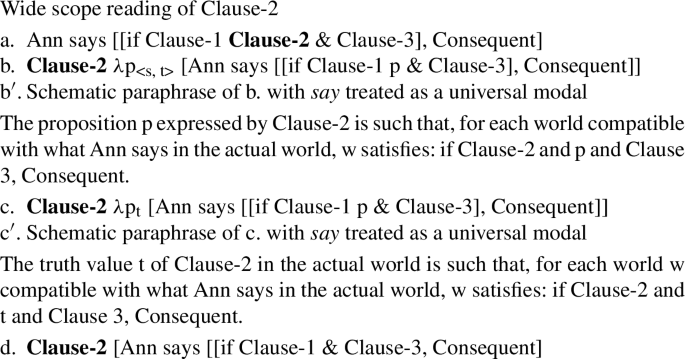
Let us consider each possibility in turn, starting with (49)b. The problem is that in this case the movement won’t affect interpretation at all. To make the technical point concrete, let’s consider a simpler case, with the semantics of conditionals in (50) within a modal semantics with a world parameter w (and an assignment function s).
-
(50)
〚if F, Q〛w, s = 1 iff for every world w′ accessible from w, if 〚F〛w′, s = 1, 〚Q〛w′, s = 1.
In this simple example, the possibility we are considering is that F is moved out if the if-clause and abstracted over as an object of type <s, t>, as in (51):
-
(51)
F λp<s, t> [if p, Q]
We need a rule to interpret this structure, and the following version of Intensional Function Application (e.g. Heim and Kratzer 1998) will do:
-
(52)
Intensional Function Application (special case) If 〚F〛s is of type <s, t> and 〚G〛w, s is of type <<s, t>, t>, 〚F G〛w, s = 〚G〛w, s(〚F 〛s).
The problem is that the fact that F appears outside the if-clause does not change the truth conditions, because in (52) the value of F is not sensitive to the value of the world parameter (as is standard, we write s[p→π] for the assignment function which is identical to s except that it assigns π to the variable p):
-
(53)

=

(by applying (52))
= [λπ<s, t> 〚if p, Q〛w, s[p→π]](〚F 〛s)
= 〚if p, Q〛w, s[p→π] with π= 〚F 〛s
= 〚if F, Q〛w, s
The same problem arises in (49)b as in (51), with the difference that the sentence is far more complicated, as it involves extraction out of a conjunction which is itself embedded within an if-clause under say. But the difficulty is the same: it is unclear how the movement of Clause-2 can affect the truth conditions.
The second possibility is to take the abstraction to be over an expression of type t rather than <s, t>, as in (49)c. This means that we must use a version of Extensional Function Application (e.g. Heim and Kratzer 1998), as in (54).
-
(54)
Extensional Function Application (special case)
If 〚F〛w, s is of type t and 〚G〛w, s is of type <t, t>, 〚F G〛w, s = 〚G 〛w, s(〚F 〛w, s).
To see the effect of the rule in a much simpler case, we consider the extraction in (55), where the propositional variable p now has type t rather than <s, t> (as in (51).
-
(55)
F λpt [if p, Q]
Contrary to the case in (53), moving F will now have an effect:
-
(56)
\([\!\![\text{F $\lambda $p$_{\mathrm{t}}$ [if p, Q]}]\!\!]\)w, s
= \([\!\![\text{$\lambda $p$_{\mathrm{t}}$ [if p, Q]}]\!\!]\)w, s(〚F 〛w, s)
(by (54))
= [\(\lambda \pi _{\mathrm{t}}\) 〚if p, Q〛w, s[p→π]](〚F 〛w, s)
= 〚if p, Q〛w, s[p→π] with π = 〚F 〛w, s
Now the truth value of F at w will be rigidly assigned to the variable p. Assuming for the sake of argument that we can proceed with the computation,Footnote 28 we will assign a specific value to π = 〚F 〛w, s. For concreteness, we take it to have the value false, i.e. 0. The computation then proceeds as in (57):
-
(57)
With π = 〚F 〛w, s = 0, 〚if p, Q〛w, s[p→π] = 1
iff for every world w′ accessible from w, if 〚p〛w′, s[p→π] = 1, 〚Q〛w′, s = 1,
iff for every world w′ accessible from w, if s[p→π](p) = 1, 〚Q〛w′, s = 1,
iff for every world w′ accessible from w, if π = 1, 〚Q〛w′, s = 1,
iff for every world w′ accessible from w, if 0 = 1, 〚Q〛w′, s = 1.
The last line is trivially satisfied, and this is a bad result: the fact that F is false in the world of evaluation makes the conditional with the moved antecedent trivially true. This problem arises in a more complex setting in (49)a analyzed as in (49)c. On the intended reading, (49)a ought to entail Clause-2, hence (49)a couldn’t be true while Clause-2 is false. But with the analysis we just sketched, this is not the case; the falsity of Clause-2 in the actual world will wrongly lead to the prediction that Ann said something trivially true (informally, the predicted meaning for (49)c is akin to: Ann says that if Clause-1 and falsity and Clause-3, Consequent).
To get out of this problem, one would need to posit, with various analyses (e.g. Schlenker 2004, among others), that a conditional whose antecedent is trivially false yields a presupposition failure. The presupposition failure of the conditional could then be expected to percolate to the matrix sentence (Heim 1992). Thus from the assumption that the asserted sentence is true, one would get the inference that Clause-2 is true in its world of evaluation—on a wide scope reading, the actual world. The full repercussions of this analysis would need to be investigated, however.
A third alternative is to posit that Clause-2 moves out without leaving behind an interpreted trace, as schematized in (49d) (with the continued assumption that parataxis is interpreted as conjunction). This might conceivably explain why this movement does not display the hallmarks of the coordinate structure constraint, since no trace is left within the syntactic island. But it remains mysterious how this operation fits with standard views on the syntax/semantics interface for movement structures.
Finally, we note that the same problems and solutions are relevant for the intermediate scope reading of Clause-2, as illustrated in (58). On the intended reading, what Ann says entails Clause-2. But on bivalent analyses of conditionals, (58)a may be true on the analysis in (58)c even though in each world compatible with what Ann says, Clause-2 is false, as this makes the embedded conditional trivially true. The presuppositional solution discussed above could presumably be applied to this case as well.Footnote 29
-
(58)

In sum, a covert movement analysis of intermediate (and wide) scope readings has two problems to address: the movement might have to be out of a coordinate island; and it might or might not yield the right inferences depending on the details of one’s analysis.
Rights and permissions
About this article
Cite this article
Schlenker, P. Non-local attachment of clauses. Nat Lang Linguist Theory 39, 887–922 (2021). https://doi.org/10.1007/s11049-020-09486-8
Received:
Accepted:
Published:
Issue Date:
DOI: https://doi.org/10.1007/s11049-020-09486-8
















